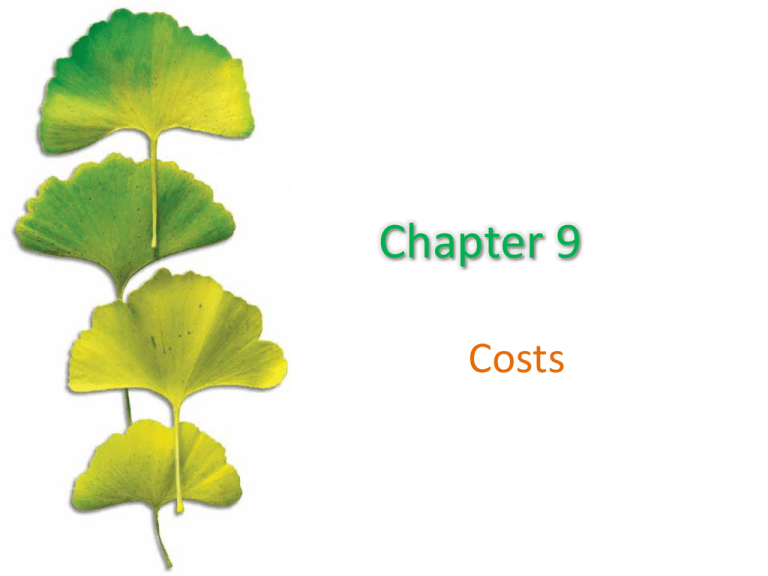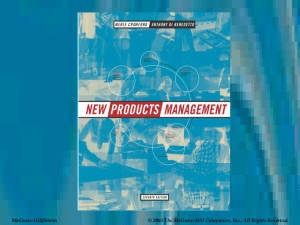
Chapter 9
Costs
Chapter Outline
• Costs In The Short Run
• Graphing the Total, Variable, and Fixed Cost Curves
• Average Fixed, Average Variable, Average Total and
Marginal Costs
• Allocating Production Between Two Processes
• The Relationship Among MP, AP,MC, And AVC
• Costs In The Long Run
• Long-Run Costs And The Structure Of Industry
• The Relationship Between Long-run And Short-run
Cost Curves
©2015 McGraw-Hill Education. All Rights Reserved.
2
Costs In the Short Run
• Fixed cost (FC): cost that does not vary with
the level of output in the short run (the cost
of all fixed factors of production).
• Variable cost (VC): cost that varies with the
level of output in the short run (the cost of
all variable factors of production).
• Total cost (TC): all costs of production: the
sum of variable cost and fixed cost.
©2015 McGraw-Hill Education. All Rights Reserved.
3
Figure 9.1: Output as a Function
of One Variable Input
©2015 McGraw-Hill Education. All Rights Reserved.
4
Figure 9.2: The Total, Variable,
and Fixed Cost Curves
©2015 McGraw-Hill Education. All Rights Reserved.
5
Figure 9.3: The Production Function
Q = 3KL, with K = 4
©2015 McGraw-Hill Education. All Rights Reserved.
6
Figure 9.4: The Total, Variable, and Fixed Cost
Curves for the Production Function Q – 3KL
©2015 McGraw-Hill Education. All Rights Reserved.
7
Other Short-Run Costs
• Average fixed cost (AFC): fixed cost divided
by the quantity of output.
• Average variable cost (AVC): variable cost
divided by the quantity of output.
• Average total cost (ATC): total cost divided
by the quantity of output.
• Marginal cost (MC): change in total cost that
results from a 1-unit change in output.
©2015 McGraw-Hill Education. All Rights Reserved.
8
Graphing the Short-run Average and
Marginal Cost Curves
• Geometrically, average variable cost at any level of output Q
may be interpreted as the slope of a ray from the origin to
the variable cost curve at Q.
• Geometrically, marginal cost at any level of output may be
interpreted as the slope of the total cost curve at that level
of output.
– And since the total cost and variable cost curves are
parallel, is also equal to the slope of the variable cost
curve.
– Marginal cost is the most important of the cost curves.
©2015 McGraw-Hill Education. All Rights Reserved.
9
Figure 9.5: The Marginal, Average Total, Average
Variable, and Average Fixed Cost Curves
©2015 McGraw-Hill Education. All Rights Reserved.
10
Marginal and Average Costs
• When MC is less than average cost (either
ATC or AVC), the average cost curve must be
decreasing with output; and when MC is
greater than average cost, average cost must
be increasing with output.
©2015 McGraw-Hill Education. All Rights Reserved.
11
Figure 9.6: Quantity vs. Average Costs
©2015 McGraw-Hill Education. All Rights Reserved.
12
Figure 9.7: Cost Curves for a Specific
Production Process
©2015 McGraw-Hill Education. All Rights Reserved.
13
Allocating Production Between
Two Processes
• Let QT be the total amount to be produced, and let
Q1 and Q2 be the amounts produced in the first and
second processes, respectively. And suppose the
marginal cost in either process at very low levels of
output is lower than the marginal cost at QT units of
output in the other (which ensures that both
processes will be used).
• The values of Q1and Q2 that solve this problem will
then be the ones that result in equal marginal costs
for the two processes.
©2015 McGraw-Hill Education. All Rights Reserved.
14
Figure 9.8: The Minimum Cost
Production Allocation
©2015 McGraw-Hill Education. All Rights Reserved.
15
Figure 9.9: The Relationship Among
MP, AP, MC, and AVC
©2015 McGraw-Hill Education. All Rights Reserved.
16
Costs in the Long Run
• Isocost line: a set of input bundles each of which
costs the same amount.
• To find the minimum cost point we begin with a
specific isoquant then superimpose a map of
isocost lines, each corresponding to a different cost
level.
– The least-cost input bundle corresponds to the point of
tangency between an isocost line and the specified
isoquant.
©2015 McGraw-Hill Education. All Rights Reserved.
17
Figure 9.10: The Isocost Line
©2015 McGraw-Hill Education. All Rights Reserved.
18
Figure 9.11: The Maximum Output
for a Given Expenditure
©2015 McGraw-Hill Education. All Rights Reserved.
19
Figure 9.12: The Minimum Cost
for a Given Level of Output
©2015 McGraw-Hill Education. All Rights Reserved.
20
Figure 9.13: Different Ways
of Producing 1 Ton of Gravel
©2015 McGraw-Hill Education. All Rights Reserved.
21
Figure 9.14: The Effect of a Minimum Wage
Law on Unemployment of Skilled Labor
©2015 McGraw-Hill Education. All Rights Reserved.
22
The Relationship Between Optimal Input
Choice and Long-Run Costs
• Output expansion path: the locus of
tangencies (minimumcost input
combinations) traced out by an isocost line
of given slope as it shifts outward into the
isoquant map for a production process.
©2015 McGraw-Hill Education. All Rights Reserved.
23
Figure 9.15: The Long-Run
Expansion Path
©2015 McGraw-Hill Education. All Rights Reserved.
24
Figure 9.16: The Long-Run Total,
Average, and Marginal Cost Curves
©2015 McGraw-Hill Education. All Rights Reserved.
25
The Relationship Between Optimal
Input Choice and Long-Run Costs
• Constant returns to scale - long-run total costs are
thus exactly proportional to output.
• Decreasing returns to scale - a given proportional
increase in output requires a greater proportional
increase in all inputs and hence a greater
proportional increase in costs.
• Increasing returns to scale - long-run total cost rises
less than in proportion to increases in output.
©2015 McGraw-Hill Education. All Rights Reserved.
26
Figure 9.17: The LTC, LMC and LAC
Curves with Constant Returns to Scale
©2015 McGraw-Hill Education. All Rights Reserved.
27
Figure 9.18: The LTC, LAC and LMC Curves
for a Production Process with Decreasing
Returns to Scale
©2015 McGraw-Hill Education. All Rights Reserved.
28
Figure 9.19: The LTC, LAC and LMC
Curves for a Production Process with
Increasing Returns to Scale
©2015 McGraw-Hill Education. All Rights Reserved.
29
Long-Run Costs and the Structure
of Industry
• Natural monopoly: an industry whose
market output is produced at the lowest
cost when production is concentrated in the
hands of a single firm.
• Minimum efficient scale: the level of
production required for LAC to reach its
minimum level.
©2015 McGraw-Hill Education. All Rights Reserved.
30
Figure 9.20: LAC Curves Characteristic of
Highly Concentrated Industrial Structures
©2015 McGraw-Hill Education. All Rights Reserved.
31
Figure 9.21: LAC Curves Characteristic
of Unconcentrated Industry Structures
©2015 McGraw-Hill Education. All Rights Reserved.
32
Figure 9.22: The Family of Cost Curves
Associated with a U-Shaped LAC
©2015 McGraw-Hill Education. All Rights Reserved.
33
Figure A9.1: The Short-run and LongRun Expansion Paths
©2015 McGraw-Hill Education. All Rights Reserved.
34
Figure A9.2: The LTC and STC Curves Associated
with the Isoquant Map in Figure A.9.1
©2015 McGraw-Hill Education. All Rights Reserved.
35
Figure A9.3: The LAC, LMC, and Two ATC
Curves Associated with the Cost Curves
from Figure A.9.2
©2015 McGraw-Hill Education. All Rights Reserved.
36
Figure A9.4: The Family of Cost
Curves Associated with a U-Shaped LAC
©2015 McGraw-Hill Education. All Rights Reserved.
37






